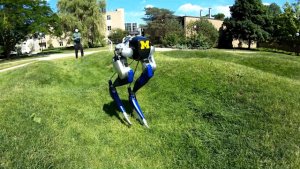Presented By: Michigan Robotics
Feedback Control of Highly Dynamic 3D Bipedal Locomotion
Robotics PhD Defense, Yukai Gong

Chair: Jessy Grizzle
Abstract:
Bipedal robots have the potential to free humans from tedious or dangerous tasks. Compared to robots in other forms, a bipedal robot has similar morphology to humans and thus can work in almost all spaces where humans work and requires little to none facility modifications. However, while many other robots are deployed in real life and are beginning to have an impact, bipedal robots are hardly seen outside of labs due to stability issues. Bipeds are inherently unstable due to their morphology. A bipedal system is nonlinear, high dimensional, hybrid, and underactuated, which poses great challenges to controller design. This thesis will therefore focus on developing control methods for biped locomotion.
First, we discuss a controller for a Cassie Robot designed with gait-library methods. The full 20 DoF dynamic model of Cassie and optimization are used to design seven gaits for walking in place, forward, and backward, while meeting key physical constraints. Moreover, we show how to practically implement these gaits on the robot.
Next, we focus on studying the dynamics of bipedal robots. We established connections between various approximate pendulum models that are commonly used for heuristic controller design and those that are more common in the feedback control literature where formal stability guarantees are the norm. We clarify commonalities and differences in the two perspectives for using low-dimensional models. In the process of doing so, we argue that models based on angular momentum about the contact point provide more accurate representations of robot state than models based on linear velocity. Specifically, we show that an approximate (pendulum or zero dynamics) model parameterized by angular momentum provides better predictions for a physical robot (e.g., legs with mass) than does a related approximate model parameterized in terms of linear velocity. We call the pendulum model parameterized by angular momentum ALIP.
Finally, we discuss general mechanisms in bipedal balance, explain why foot placement is the most effective method, and select it as our major method to stabilize a bipedal gait. We focus on regulating angular momentum about the contact point with the ALIP model. We implement a one-step-ahead angular-momentum-based walking controller on Cassie, a 3D robot, and demonstrate high agility and robustness in experiments. We also design a running controller with the same methodology and demonstrated the results in simulation and experiments.
Abstract:
Bipedal robots have the potential to free humans from tedious or dangerous tasks. Compared to robots in other forms, a bipedal robot has similar morphology to humans and thus can work in almost all spaces where humans work and requires little to none facility modifications. However, while many other robots are deployed in real life and are beginning to have an impact, bipedal robots are hardly seen outside of labs due to stability issues. Bipeds are inherently unstable due to their morphology. A bipedal system is nonlinear, high dimensional, hybrid, and underactuated, which poses great challenges to controller design. This thesis will therefore focus on developing control methods for biped locomotion.
First, we discuss a controller for a Cassie Robot designed with gait-library methods. The full 20 DoF dynamic model of Cassie and optimization are used to design seven gaits for walking in place, forward, and backward, while meeting key physical constraints. Moreover, we show how to practically implement these gaits on the robot.
Next, we focus on studying the dynamics of bipedal robots. We established connections between various approximate pendulum models that are commonly used for heuristic controller design and those that are more common in the feedback control literature where formal stability guarantees are the norm. We clarify commonalities and differences in the two perspectives for using low-dimensional models. In the process of doing so, we argue that models based on angular momentum about the contact point provide more accurate representations of robot state than models based on linear velocity. Specifically, we show that an approximate (pendulum or zero dynamics) model parameterized by angular momentum provides better predictions for a physical robot (e.g., legs with mass) than does a related approximate model parameterized in terms of linear velocity. We call the pendulum model parameterized by angular momentum ALIP.
Finally, we discuss general mechanisms in bipedal balance, explain why foot placement is the most effective method, and select it as our major method to stabilize a bipedal gait. We focus on regulating angular momentum about the contact point with the ALIP model. We implement a one-step-ahead angular-momentum-based walking controller on Cassie, a 3D robot, and demonstrate high agility and robustness in experiments. We also design a running controller with the same methodology and demonstrated the results in simulation and experiments.